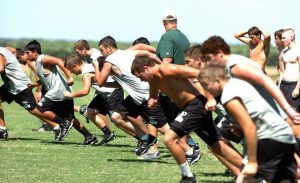LovePrints - The Line. Conditioning.
Great lines make great coaches. Great coaches make great lines. Love Out Loud.

- THE. LINE.
As a player, as a coach there are certain inevitable things. Some are good, some are dreaded, and all of them have purpose. All of them belong. All of them send us forward with something stronger and better than what we had before it. There are often constants in sports, and conditioning is one of them. It is never pleasing, often painful, and always the truth. It is also where winners show up, acknowledge, and crown themselves. It is where the line is drawn.
As any of my teammates, and any of my players, wind sprints are going to happen. They are going to happen. They are going to happen. Sometimes, they are masked as kickoff drills. Sometimes, they are masked as baserunning drills. Sometimes, they are masked as transition drills. They can include oars and shells held over head, They can include stairs, hallways, gymnasiums, tracks, and mud. They might be. But sometimes, they are not masked at all. They are simply conditioning. They are lung busting, leg dragging, tongue wagging, stomach upsetting, sweat puddle inducing, cramps in the side reminders of why game days are fun.

It does not matter what sport it is, what age group it is, or what gender. Conditioning must be done. It serves as the measuring stick for readiness, preparation and commitment. If a coach wants to know how much this sport matters to his players, he can look on day one of tryouts or practice to see who has put in the work. Coaches know who is in shape, who isn’t, and how much work it will take to get everyone on the same level.
Parents often miss this part of coaching. When the players show up on day one, they may or may not have an idea of how much work their young one has put in. More importantly, they may or may not know how much work the OTHER young people put in. They may believe that their athlete has worked hard, but have they worked as hard as the athletes they are competing with? Have they worked as hard as they could? Have they worked as hard as the athletes they are competing against? That is the line.

As players, if they do not know how much is enough, they need to ask. They need to know. What they think is enough may be enough for beginners. Or average. Or good. It may not be great. It may not be their best. That is the line.
How conditioning is done varies from climate to climate, coach to coach, and program to program. Recent awareness has asked, begged even, that conditioning be done as a part of the skill training rather than as punishment. It should be done as a part of the practice plan, a part of the improvement session, a part of the warm up and cool down. It needs to be ambitious, motivating, and sensible. It also needs to be the standard. It needs to be the line. And that line needs to be new and moved daily. That is the purpose of the line.
It is the sound that makes skin crawl, smiles disappear, sweat appears, and deep breaths happen. It is the beginning bell or the final whistle. It is the most feared sound of any practice session, and it is also the signal that we must come together and get better.
It is also the gatekeeper, the babysitter, and the constant reminder. It is the dog at the fence, it is the alarm on the door, and it is the latch on the window. It keeps order, and creates unity.
I am sure that anyone that has played for me will wince at the final sentence of this piece. It means that it is time to be measured. It is time to improve. It is time to grow. It is time to prepare for the final out, the final quarter, the last drive, the final lap, the last jump, the big shot, the next base, and the huge play. It is the line.
ON THE LINE! ON THE LINE! ON THE LINE!
<whistle>
